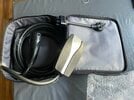I have never used the 13amp charger (never had it out of the case) it consists of two pieces (see attached pic) one piece being a 3 pin plug on a short lead to a socket that fits into the large grey and silver thing. I presume i simply join it all together and plug it into a 13amp socket?
What is the large grey and silver thing and why is the 3 pin plug separate?
What is the large grey and silver thing and why is the 3 pin plug separate?
Attachments
Last edited:



